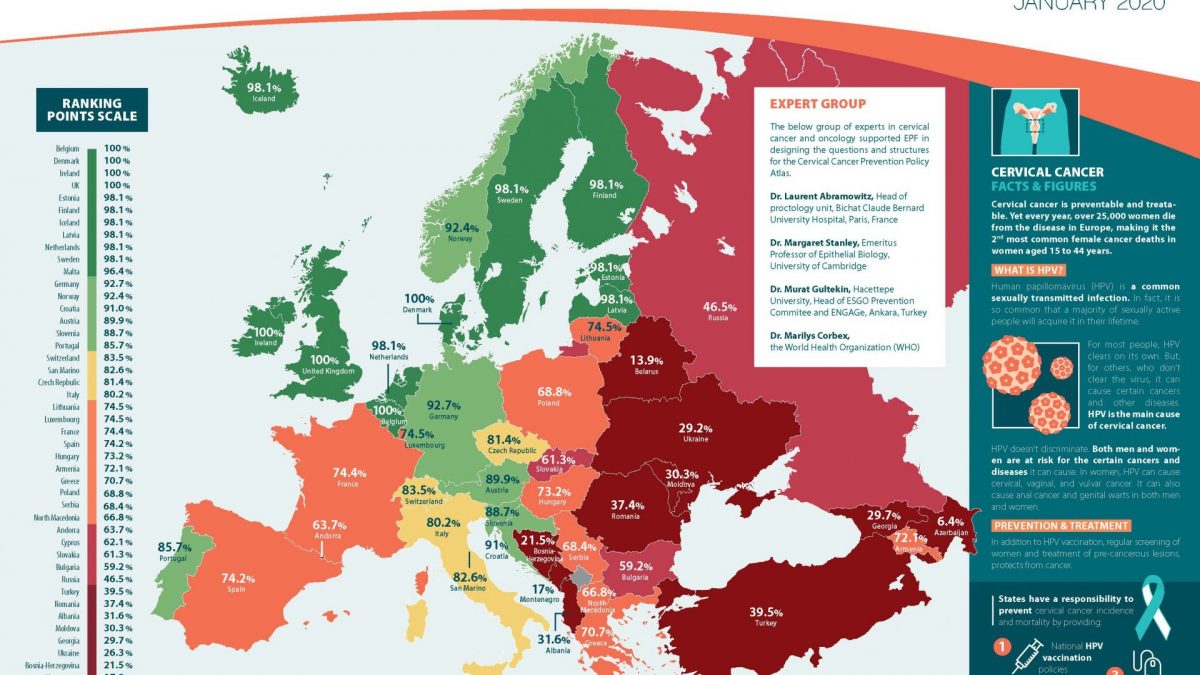
- Every year, over 25,000 women die from cervical cancer in Europe
- HPV vaccine almost 100% effective in in preventing the persistent HPV infections that cause cervical cancer
- All 46 countries need to do more to put an end to preventable deaths
- Belgium, Denmark, Ireland and the UK are the policy champions
- Azerbaijan and Belarus worst performing countries
LONDON – an atlas that scores 46 countries throughout geographical Europe on cervical cancer prevention policy launches today in London. The launch is set during the UK’s Cervical Cancer Prevention week and ahead of World Cancer Day on 4 February.
The rankings, which are based on national cervical cancer screening and HPV vaccination programmes as well as online information, reveal a very uneven picture across Europe.
The European Parliamentary Forum for Sexual and Reproductive Rights (EPF) produced the Atlas, supported by experts in cervical cancer and oncology.
“HPV-related cervical cancer is a preventable and curable disease. It is established that vaccination and well-organised cervical screening programmes can reduce cervical cancer incidence and mortality and yet some European countries are failing to provide these policies that can truly save women’s lives”, commented Neil Datta, EPF Secretary.
“While effective policies and political will are a crucial step in the right direction, without proper implementation of the policies, cervical cancer incidence and mortality rates will still remain high.”
The Atlas clearly illustrates the issue of healthcare inequality across Europe with eastern and southern countries lagging behind in cervical cancer prevention policies, which unfortunately results in a disproportionately heavy burden of cervical cancer incidence and mortality in those regions.
“Nobody should be denied healthcare according to where they live. All European governments need to do more to raise public awareness around HPV and cervical cancer to ensure more people are vaccinated and regularly attending cervical screening tests. A simple first step is to improve online information on HPV and cervical cancer prevention.”
Highlights from the findings and key statistics
Current estimates indicate that every year, 61,072 women are diagnosed with cervical cancer and 25,829 die from the disease in Europe.
In Europe, cervical cancer ranks as the 9th most frequent cancer among women and the 2nd most common female cancer deaths in women aged 15 to 44 years.
Belgium, Denmark, Ireland and the UK take the top spot with 100% scores for their cervical cancer prevention policies.
There is a clear divide between regions, with western and northern Europe ranking higher than eastern and southern Europe.
Fifteen countries have an excellent government-supported website with information on HPV, vaccination, cervical cancer and screening.
European Union Member State Romania ranks among bottom ten countries.
Azerbaijan comes in last place with no policy recommendation for HPV vaccination and no cervical cancer screening.
Eight European countries do not provide primary prevention to cervical cancer (national policy on HPV vaccination).
Sixteen countries do not provide organised population-based secondary prevention to cervical cancer (cervical cancer screening).
Poland and Russia offer little to no reimbursement for HPV vaccination.